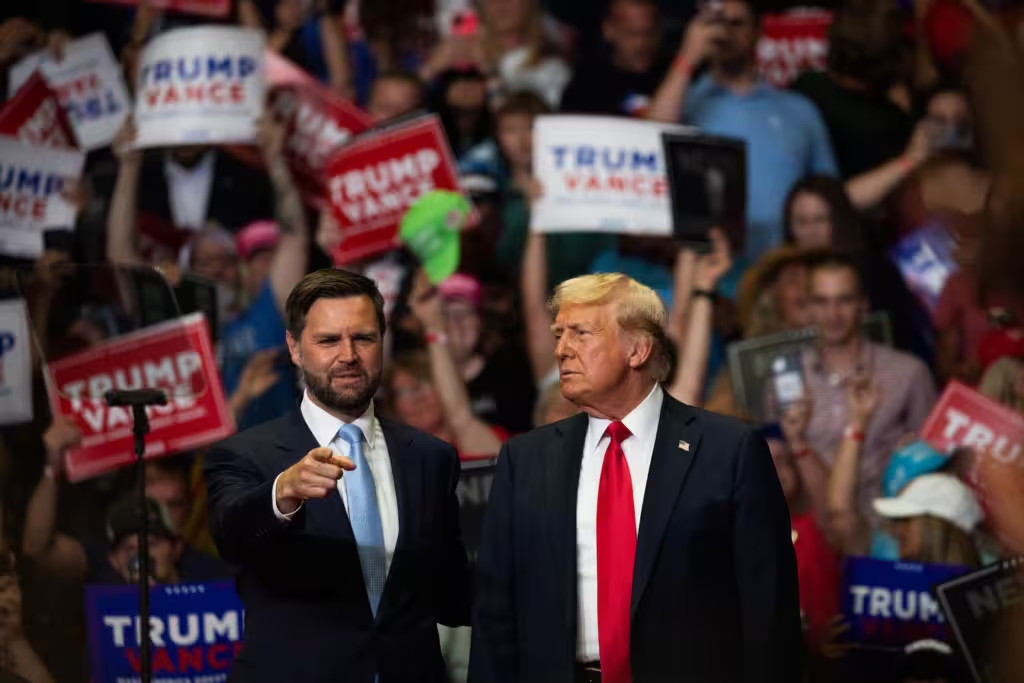2024 Presidential Election: A Night of High Stakes and Anticipation

Image Courtesy of ABC News
By Francesca Jonica
As the 2024 presidential election reached its climax, Americans across the nation tuned in, anxiously awaiting the results that would determine the direction of the country for the next four years. The anticipation was palpable, whether you hoped for a second term under President Trump or a new beginning with Vice President Kamala Harris. This election night was a defining moment, not just for the candidates but for a country deeply engaged in its democratic process.
The day began at dawn, with polling stations opening as early as 6 a.m. in many states. Voters came out in record numbers, marking a peak in civic engagement that underscored the high stakes of this election. By evening, as polling places began to close at 7 p.m., early results started trickling in, setting off a wave of reactions from supporters on both sides. Indiana and Kentucky, traditionally Republican strongholds, declared victories for Trump at 7:10 p.m., securing him an early 19 electoral votes. Simultaneously, Vermont, a reliably blue state, declared support for Harris, giving her the first three votes in her electoral count.
Election day, however, was not without its disruptions. In Georgia’s Fulton County, a series of bomb threats forced temporary closures at multiple polling sites. Georgia Secretary of State Brad Raffensperger reported that the threats might have been foreign interference, potentially linked to Russia. In response, Georgia extended voting hours in the affected locations, demonstrating a commitment to ensuring that no one would be denied their right to vote due to intimidation or fear. This incident highlighted the vulnerability of the electoral process in today’s global political climate and the resilience of state officials determined to uphold democratic integrity.
As the clock struck 8 p.m., Trump held a lead with 95 electoral votes, while Harris had accumulated 35. This early advantage ignited hope among Trump supporters, but Harris’s camp remained optimistic, knowing many key swing states had yet to report. The race was far from over, and as more states prepared to announce their results, viewers around the country settled in for a long night.
By 9 p.m., a clearer picture of the electoral map began to form. With 24 states called, Trump had secured 137 electoral votes, and Harris had risen to 99. The margins were narrow in critical states, making every precinct’s report feel like a revelation. The tension was especially high in states like Pennsylvania and Wisconsin, where urban and rural votes often swing the outcome in unpredictable ways. Both campaigns understood that these battleground states could make or break their path to the presidency.
Election night wasn’t only about the presidency; key Senate races also shaped the evening. At 8 p.m., Republican Rick Scott secured re-election in Florida, opening his acceptance speech with “I thank God,” a nod to his faith and the conviction that underpinned his campaign. Scott’s win boosted Republican spirits, symbolizing continued conservative influence in critical states.
In Ohio, all eyes were on the intense Senate race between Democratic incumbent Sherrod Brown and Republican Bernie Moreno. The vote counts seesawed late into the night, highlighting the Midwest’s evolving political terrain, where both urban and rural voters wield strong influence. By midnight, the contest remained too close to call, keeping Ohioans—and the country—on edge.
Meanwhile, in Maryland, Democrat Angela Alsobrooks won the Senate race against former Governor Larry Hogan by a 7 percent margin. This Democratic hold was a notable achievement in a blue-leaning state, where Hogan’s bipartisan appeal had made the race unexpectedly competitive. Alsobrooks’ win reflected Maryland’s current political leanings and underscored the importance both parties are placing on appealing to moderate voters.
As midnight passed and results continued to come in, it became clear that the race was going to be exceptionally close. Americans from all walks of life, in cities, towns, and rural communities, either stayed glued to their screens or went to bed with a lingering sense of uncertainty. By 3 a.m., Vice President Kamala Harris’s campaign chair delivered a brief speech, conceding that Trump appeared poised to win. However, with several states still too close to call, the nation remained in suspense.
As dawn broke, the final numbers solidified. At 5 a.m., Trump had amassed 267 electoral votes to Harris’s 204. The remaining states were leaning towards the Republican ticket, and by 6 a.m., it was officially announced that Donald Trump had won a second term as President, with Ohio Senator JD Vance confirmed as his Vice President.
The nation now looks to the future, with the inauguration set for January. Trump’s win reflects a country grappling with a range of complex issues, from economic recovery to border security, healthcare, and foreign policy. The campaign season, characterized by passionate debates and sharply contrasting visions, showcased the depth of American democracy and the intensity of civic engagement among the public.
This election underscores that the American democratic process remains vibrant and complex. As both Trump and Harris have emphasized, the ultimate responsibility now rests with the people and their representatives to bridge divides and work toward a more unified future. The 2024 election was not just a competition for the White House; it was a snapshot of a nation in dialogue with itself, wrestling with its values, priorities, and aspirations.
In the weeks leading up to the inauguration, the conversation will continue, as citizens from every corner of the nation reflect on what this election means for them and for the generations to come. As always, America moves forward—sometimes together, sometimes divided—but always with resilience and a spirit of hope for a brighter tomorrow.






